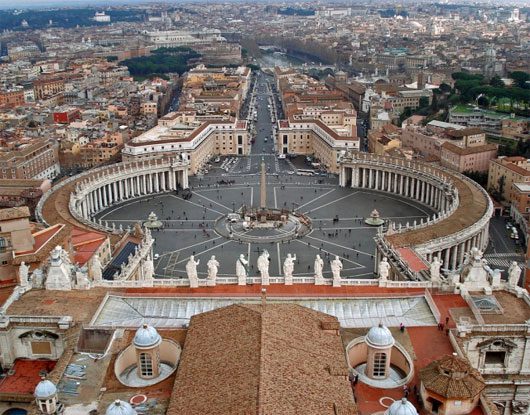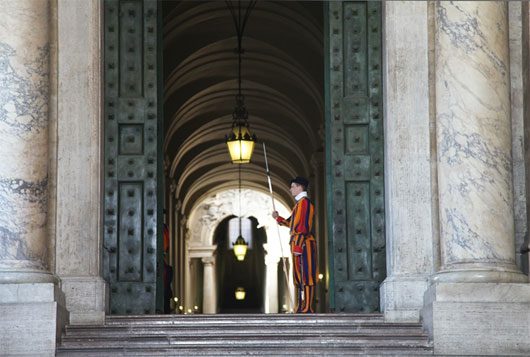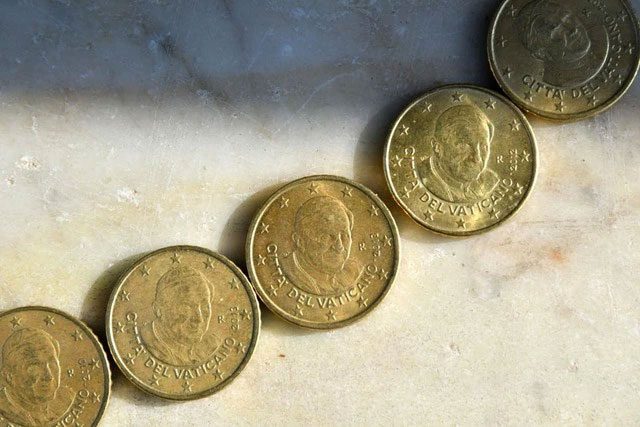Visitors to Italy cannot miss the city of Rome, and once in Rome, they must visit Vatican City – the smallest and most peaceful country on the planet.
Interesting Secrets About Vatican City
- 1. Vatican is the smallest country in the world
- 2. St. Peter’s Basilica is built on an ancient cemetery
- 3. The obelisk in St. Peter’s Square was brought by Emperor Caligula
- 4. For about 60 years in the 19th century, popes refused to leave Vatican City
- 5. Benito Mussolini signed the agreement recognizing the independence of Vatican City
- 6. Popes did not live in Vatican until the 14th century
- 7. Swiss Guards are hired as the national military force
- 8. Throughout Vatican’s history, popes were evacuated through secret passages
- 9. Most Vatican citizens live abroad
- 10. The Vatican Observatory owns a telescope in Arizona (USA)
- 11. The country with the highest number of tourists in the world
- 12. Vatican has its own currency
- 13. It has the best postal service in the world
- 14. The shortest railway in the world
- 15. The entire country is a UNESCO World Heritage Site
- 16. There are no hospitals or prisons
Despite its small size, Vatican City is considered one of the most powerful nations today, serving as the official residence of the Pope and other religious dignitaries of the Catholic Church.
Enclosed and separated from Rome by medieval and Renaissance walls, this powerful nation holds many interesting facts that you may not know.
1. Vatican is the smallest country in the world
Nestled within Italy with a border length of 2 miles (3.2 km), Vatican City State, in Italian known as Stato della Città del Vaticano, spans an area of 44 hectares (about 1/8 the size of Central Park in New York, USA). Vatican has a monarchy system led by the Pope, who is the only absolute monarch in Europe, holding supreme legislative, executive, and judicial powers.
The currency of Vatican is the Euro, and it has its own stamps, passports, license plates, national flag, and anthem. However, this government does not have a tax system. Income for Vatican comes from ticket sales to museums, stamps, souvenirs, and contributions from various organizations.
2. St. Peter’s Basilica is built on an ancient cemetery

Vatican and St. Peter’s Square from above. (Image: womenofgrace.com)
Historically, the Roman cemetery was located on Vatican Hill. After a great fire devastated the city in 64 AD, Emperor Nero sought to shift the blame onto Christians, accusing them of causing the fire. He executed them by burning, tearing apart by wild animals, and crucifying. Among the victims was St. Peter, the leader of Jesus’s apostles and the first bishop of Rome. His remains are believed to be buried under Vatican Hill.
In the 4th century, Christianity was legally recognized in Rome, and Emperor Constantine began constructing a church over the ancient tomb, believed to be the resting place of St. Peter, right at the center of the structure. The current basilica was commissioned in the 1500s.
3. The obelisk in St. Peter’s Square was brought by Emperor Caligula
During his reign, Roman Emperor Caligula constructed a circus in his mother’s garden at the foot of Vatican Hill. It was here that he trained charioteers, and it is believed that Christians were executed at this site. To decorate the square, Caligula had his army bring back an obelisk from Egypt, originally erected in Heliopolis.
This granite obelisk, weighing over 350 tons and made from a single piece, was erected by the Pharaohs in Egypt over 3,000 years ago. In 1586, it was brought to St. Peter’s Square as decoration and also served as a giant sundial.

The obelisk in the center of the square brought by Emperor Caligula. (Image: wpr.org)
4. For about 60 years in the 19th century, popes refused to leave Vatican City
When Vatican was still a state within Italy, known as the Papal States, the popes refused to acknowledge Vatican’s existence under Italian administration. Pope Pius IX (March 13, 1792 – February 7, 1878, reign: 1846 – 1878) famously declared himself a “prisoner in Vatican.” For 60 years, popes refused to leave Vatican and recognize the power of the Italian government. When Italian troops entered St. Peter’s Square, the popes did not appear on the balcony and refused to bless them.
5. Benito Mussolini signed the agreement recognizing the independence of Vatican City
The dispute between the Italian government and the Catholic Church in Vatican ended in 1929 with the Lateran Pacts, allowing Vatican to exist independently with a compensation payment to the Papal States of 93 million dollars (equivalent to about 1 billion dollars today). Vatican used this money to establish its national treasury. Mussolini, who led the Italian government at the time, signed the treaty on behalf of King Victor Emmanuel III.
6. Popes did not live in Vatican until the 14th century
Even after St. Peter’s Basilica was completed, popes primarily resided at the Lateran Palace in Rome. They even left the city together for Avignon, France, in 1309 when King Philip IV arranged for a French cleric to be elected pope. Seven French popes led the church from Avignon and did not return to Rome until 1377, when the Lateran Palace burned down, and Vatican began to be used as the residence of popes.
Many restoration activities were performed as the architectural infrastructure of Vatican was in a state of severe disrepair, with wolves digging up graves in the cemetery, and cattle roaming around the church.
7. Swiss Guards are hired as the national military force
When visiting Vatican, tourists easily encounter The Swiss Guard – the colorful uniformed guards. They have been protecting the pope since 1506, when Pope Julius II was in power, following the trend of many prestigious individuals in Europe hiring Swiss soldiers for safety.
This guard regularly patrols and closely monitors the entire Vatican City. They are well-trained, disciplined, and skilled marksmen. Naturally, all members of the guard are Swiss citizens.

The Swiss Guard has protected Vatican and the Pope since 1506. (Image: dogsqueen.pixnet.net)
8. Throughout Vatican’s history, popes were evacuated through secret passages
In 1277, the Passetto di Borgo route was built to connect Vatican with Castel Sant’Angelo along the Tiber River. It was used as an emergency escape route for popes.
A notable instance was in 1527 when Pope Clement VII was safely evacuated from Vatican while Rome was under threat from the army of Charles V. They ruthlessly slaughtered clergy and nuns in the city, and the Swiss Guard held off long enough for the pope and some monks to escape through the secret passage to Castel Sant’Angelo, but 147 clergy members lost their lives in this massacre.
9. Most Vatican citizens live abroad
In 2011, the population of Vatican was 594, and the latest figure in 2013 showed 839 people. Many citizens hold Vatican citizenship but actually live abroad (primarily in Rome, Italy). Besides the Swiss Guard, which consists of around 100 members, the largest community in Vatican is made up of priests from around the world who come to live and study here.
10. The Vatican Observatory Owns a Telescope in Arizona (USA)
As Rome evolved into a bustling metropolis, the city lights hindered astronomers from the smallest country in the world from observing constellations clearly. The Vatican Observatory is located 15 miles from the city center at Castel Gandolfo.
In 1981, the Vatican established an additional research center in Tucson, equipped with a modern telescope situated atop Mount Graham, in southeastern Arizona, USA.
The Vatican has even more intriguing experiences waiting for you to explore, with St. Peter’s Basilica filled with artistic masterpieces, the Vatican Library housing millions of books, or simply standing in St. Peter’s Square. Who knows, you might catch a glimpse of Pope Francis waving at the crowd from the balcony.
11. The Country with the Highest Number of Tourists in the World
As of 2015, the estimated population of the Vatican was around 1,000 people. With tourist numbers reaching up to… 5 million visits per year, the Vatican has become the country with the highest number of tourists in the world, based on per capita statistics.
The population of the Vatican includes cardinals, members of the Swiss Guard, members of the clergy, and a nun within the Vatican City. Additionally, there are clergy members working in diplomatic positions abroad.
12. Vatican Has Its Own Currency
In 2000, Italy and the Vatican signed an agreement, allowing the Holy See to adopt the Euro as its official currency. The Vatican began minting its own Euro coins in 2002. Interestingly, the Vatican Euro is legal tender in both Italy and the Vatican and can circulate freely throughout the Eurozone.
In addition, the Vatican also issues its own passports and vehicle registration plates, as well as printing its own stamps.

Vatican mints its own Euro.
13. The Best Post Office in the World
The postal service of the Vatican is considered the best in the world, with the volume of mail sent from its postal code each year exceeding that of any other place globally. It is believed that most residents prefer to visit this post office weekly to send their mail instead of relying on Italy’s national postal service. This post office has been in operation since 1929.
14. The Shortest Railway in the World
With a railway network consisting of only two tracks measuring 300 meters, the Vatican proudly holds the title of having the shortest railway system in the world, featuring just one train station, known as Città del Vaticano. The railway is primarily used for freight transport. Another interesting fact about this railway network is that there are no regular passenger trains.
15. The Entire Country is a World Heritage Site
The Vatican is the only country recognized as a World Heritage Site by UNESCO, receiving this designation in 1984.
The Vatican also has its own national flag and anthem. The main revenue for the country comes from entrance fees to museums and the sale of souvenirs.
16. No Hospitals or Prisons
In fact, no babies are born in the Vatican as the country does not have a hospital. However, citizenship is not based on being born in this country. No one can be a citizen of the Vatican by birth. Citizenship in this tiny nation is only granted based on appointment to serve in the Holy See.


















































